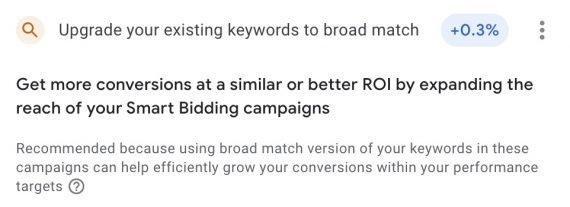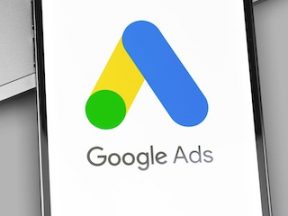It’s time to assess the direction of Google Ads for 2023. What follows are four themes based on the features that grew in prominence during 2022 and trends of the last few years.
Broad Match Comeback
With few exceptions, Smart Bidding delivers the best results and account growth. Google’s automation and machine learning consider hundreds of signals that manual bidding cannot. The more data it collects, the better Google can optimize desired conversions.
According to Google, broad match collects the most data faster and thus pairs well with Smart Bidding strategies. Upgrading existing keywords to broad match is Google’s suggestion in the “Recommendations” admin tab.

Google suggests in the “Recommendations” tab to upgrade existing keywords to broad match.
However, advertisers should closely monitor broad match, as it could produce overspend from irrelevant queries. Traffic will likely rise but not necessarily conversions.
Nonetheless, broad match is necessary for account growth. Over the long term, broad-match keywords produce quality impression share and higher conversions. Pairing broad-match keywords with audiences provides Google with more data to optimize Smart Bidding. But, again, review search query reports continually and quickly pause ineffective broad match keywords.
There are a couple of ways to test broad match. The conservative approach is to add broad-match keywords to the ad groups with low impressions. For example, if you have 10 ad groups and three have fewer than 1,000 monthly impressions, start with those three.
The aggressive approach tests broad matches in the high-impression ad groups. You’ll see an impact right away — good or bad.
More Dependence on Creative
It’s hard to succeed in Google Ads with just text. Consumers expect to see ads with quality images and videos. And all Display Network ad types — e.g., Responsive, Discovery, Performance Max — require images.
Google encourages videos for Responsive Display and Performance Max ads. Depending on the ad type, advertisers can submit up to 20 images that Google will rotate. Google will show the combinations of text, images, and videos likely to perform best.
Engaging videos are essential for campaigns on YouTube and Google video partners. Google offers a simple video creation template tool to help.

Google provides a template tool for creating campaign videos.
Search ads can use images to differentiate from the competition. In the example below, KÜHL, an outdoor clothing store, uses an image to complement the ad copy, while Carhartt does not.

KÜHL stands out from its competitor, Carhartt, by using an image.
In 2023, emphasize the creative. Create or repurpose images and videos for Google Ads and, if helpful, store them in Google’s asset library.
Privacy-focused Management
The digital marketing industry is slowly moving to first-party data and away from cookies. Google is no different. It created its own tag to capture user data. Segments such as customer match lists and specific site actions will remain important. Advertisers should ensure all data is being tracked correctly and the segments can be uploaded to Google.
Google is changing data segments on May 1, 2023, when advertisers can no longer create similar audiences, even with first-party data. Instead, customer match lists will be a signal in Smart Bidding in Search and Shopping campaigns. Enable the “optimized targeting” feature for Display campaigns to use first-party data. The algorithm will then use these segments to find new and similar users.
Less Transparency to Advertisers
Google’s automation and machine learning algorithms are largely a mystery. The algorithms consider hundreds of signals, but advertisers have little insight into what they are. For example, we can view overall responsive search ad performance but not for each asset and combination.
Advertisers must work within those limits while looking for opportunities. We don’t know every signal Google uses to optimize a bid strategy, but we can choose the conversions to focus on. The key is balancing what the algorithms do best and how we, as advertisers, can improve the results.




